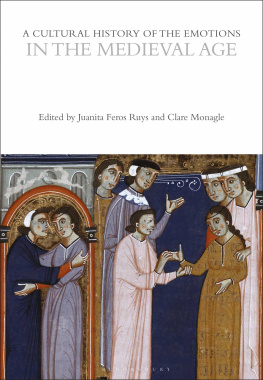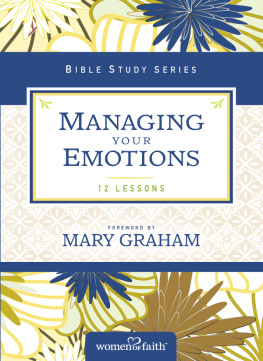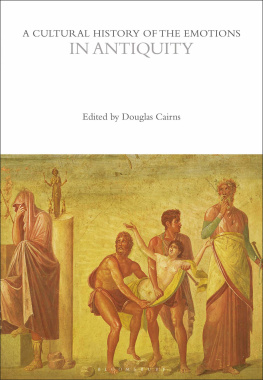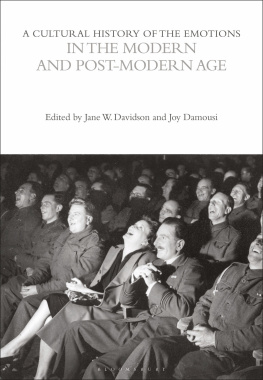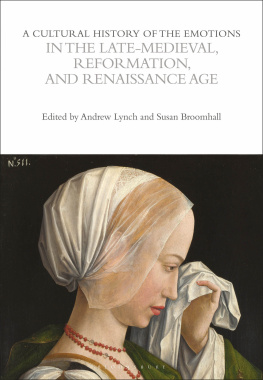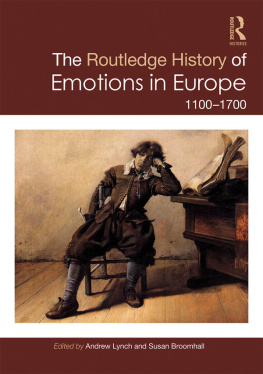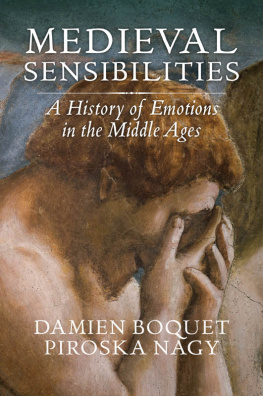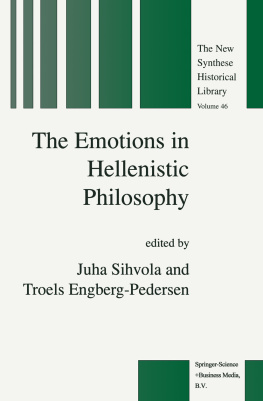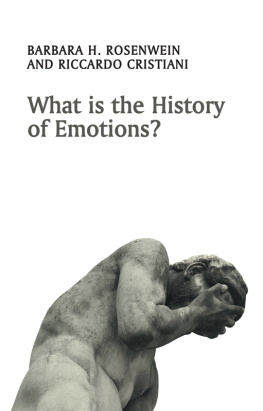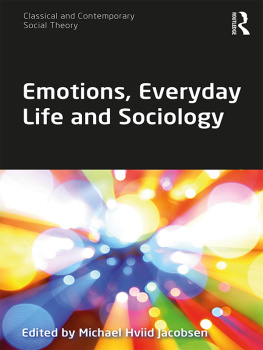
A CULTURAL HISTORY
OF THE EMOTIONS
VOLUME 2
A Cultural History of the Emotions
General Editors: Susan Broomhall, Jane W. Davidson, and Andrew Lynch
Volume 1
A Cultural History of the Emotions in Antiquity
Edited by Douglas Cairns
Volume 2
A Cultural History of the Emotions in the Medieval Age
Edited by Juanita Feros Ruys and Clare Monagle
Volume 3
A Cultural History of the Emotions in the Late Medieval, Reformation, and Renaissance Age
Edited by Andrew Lynch and Susan Broomhall
Volume 4
A Cultural History of the Emotions in the Baroque and Enlightenment Age
Edited by Claire Walker, Katie Barclay, and David Lemmings
Volume 5
A Cultural History of the Emotions in the Age of Romanticism, Revolution, and Empire
Edited by Susan J. Matt
Volume 6
A Cultural History of the Emotions in the Modern and Post-Modern Age
Edited by Jane W. Davidson and Joy Damousi

CONTENTS
INTRODUCTION
Church of Saint-Ouen de Rouen (interior).
The Descent from the Cross (detail), by Rogier van der Weyden, c.1435.
The Douce Apocalypse.
Augustine, by Simone Martini, c.13201325.
Exorcism of the Demons at Arezzo, fresco (detail), Saint Francis cycle by Giotto (c.12671337).
CHAPTER 1
Saffron in the Circa Instans, c.1280c.1310.
The Three Spirits.
Veins in the Body, c.142030.
Ventricles of the Brain, c.1347.
CHAPTER 2
Temptation of St. Anthony, by Master of Bonnat (active c.14751530).
St. Jerome in His Study, by Albrecht Drer, 1514.
St. Wiborada in her anchorite cell, St. Gallen, 145160.
CHAPTER 3
The responsory Fulgebat in venerando, thirteenth century.
Statue of Guido of Arezzo, outside the Uffizi Gallery, Florence, Italy, sculpted by Lorenzo Nencini, c.1837.
Detail of Loves Dance (La karole damours) from the Roman de la Rose, depicting ten figures dancing to drum and bagpipes.
CHAPTER 4
Lid of a box, fragment, ivory. Thalia, Muse of Comedy with lyre, masks, and sword, fifth century.
The Three Marys at the Tomb, Benedictional of Aethelwold.
Battle of Patience and Anger (Pacienciam ira percutit gladio), Prudentius, Psychomachia.
Ambrogio Lorenzetti, Miracle of the Poor Youth, Scenes of the Life of Saint Nicholas, c.1332.
God confronts Adam and Eve, mosaic, Cathedral of the Assumption, Monreale, Sicily, twelfththirteenth century.
CHAPTER 5
Slaughter of the Innocents, Codex Egberti, tenth century.
Adam and Eve after the Fall, Vienna Genesis, sixth century.
Expulsion from Eden, stained glass, Cathedral of Soissons, c.12001225.
Last Judgment Tympanum of the Frstenportal, Cathedral of Bamberg, c.1230.
Lintel frieze from the Last Judgment Portal, Cathedral of St-Lazare, Autun, c.1130.
Throne of Wisdom/Enthroned Virgin and Child, c.11501200.
Rttgen Piet, c.1325.
Giotto di Bondone, Lamentation (The Mourning of Christ), 13041306.
Penitence, Devotion, and Contemplation, MS Yates Thompson 11, c.1290.
CHAPTER 6
Chastity pierces Lust with her sword (Pudicicia transfigit libidinem gladio), Prudentius, Psychomachia.
Boethius, Philosophy, and the Muses. Miniature from Boethius, De consolatione philosophiae (Consolation of Philosophy).
Hildegard of Bingen receives a vision from God and dictates it to her scribe and secretary. Illumination from Hildegard of Bingen, Liber Scivias, Rupertsberg Codex, c.1175.
Tristan and Isolde, c.125075.
The Lover enjoys the Rose, Guillaume de Lorris/Jean de Meun, Roman de la Rose.
CHAPTER 7
Mother instructing her daughter, Die Winsbeckin, c.13001340.
Mother buried cradling a child, excavated in 1985 at Butlers Field, Lechlade, Gloucestershire.
CHAPTER 8
Peter looking remorseful. Carved alabaster column from the tabernacle of the high altar, St. Marks Basilica, Venice.
Suicide of Judas. Carved alabaster column from the tabernacle of the high altar, St Marks Basilica, Venice.
Penance on a tailless horse, Romance of Lancelot du Lac, c.132030.
Gestures and emotions in council, Bayeux Tapestry, eleventh century.
An extravagant female mourner. Polyptych with scenes from the life of Christ, the life of the Virgin, and saints, workshop of Ferrer Bassa, Spain, c.134550.
The General Editors, volume editors and individual authors of this series have many organizations to thank for helping to bring it into existence. They gratefully acknowledge assistance from the Arts and Humanities Research Council (UK); the European Research Council Project, The Social and Cultural Construction of Emotions, University of Oxford, and its Director, Professor Angelos Chaniotis; and the Leverhulme Trust. Above all, the series has depended on support from the Australian Research Council Centre of Excellence for the History of Emotions (CE110001011). The project was conceived as a key part of the Centres collaborative research work and has benefited greatly from the generous help of its academic and administrative staff.
The General Editors also express their deep gratitude to the volume editors and authors for their time, expertise and gracious willingness to revise essays in the light of readers comments. Many other people helped in reading, tracing images and advising in various ways. Our thanks go to Merridee Bailey; Jacquie Bennett; Sophie Boyd-Hurrell; Frederic Kiernan; Mark Neuendorf; Fiona Sim; and Stephanie Thomson; and to the patient staff at Bloomsbury: Dan Hutchins; Claire Lipscomb; Beatriz Lopez; and Rhodri Mogford. We especially acknowledge Ciara Rawnsley, who as Editorial Assistant for the entire series has tirelessly helped authors and done indispensable and meticulous work on all aspects of the volumes preparation.
This series is dedicated to the memory of Philippa Maddern (19522014) who was an original General Editor, and an inspiring friend, mentor and colleague to many of the contributors.
CLARE MONAGLE
EMOTIONS HISTORY AND THE MIDDLE AGES
At first glance, the world of the European Middle Ages seems very far removed from our own twenty-first-century experience. We are separated by time, yes, but also by technology, language, economy, religion, and myriad other aspects of being. Even after many years of studying the Middle Ages, I am often struck by what feels like the foreign formality of the period expressed within its cultural artifacts. Standing in a Gothic cathedral (see Figure 0.1), or reading medieval theology, or gazing at a manuscript, I feel that I am inside a world of codes and rules that I can respect, but which remain distant. We know that medieval people loved, fought, birthed, and died. They lamented, fumed, sulked, smiled, and sobbed. We feel like we know that because they were human like us, and we think we know because extant medieval sources give us glimpses of the way their feeling bodies expressed themselves in language and gesture. But given the distance between them and us, can we ever properly encounter the emotions of the Middle Ages?
Next page
